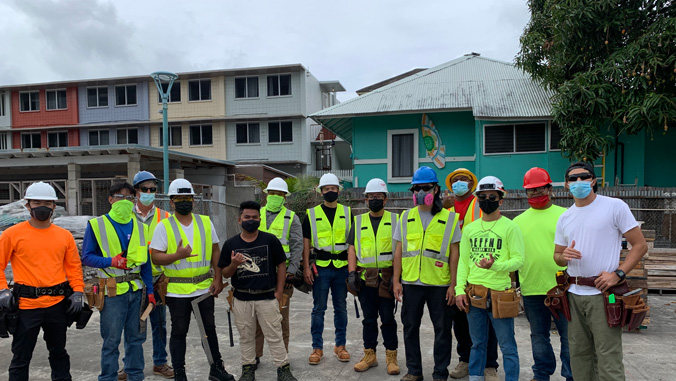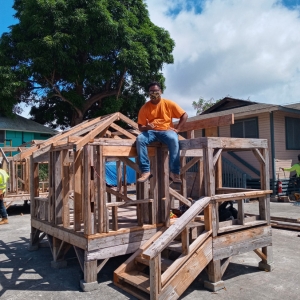
Carpentry student Rayvan Kebekol is building towards his future at Honolulu Community College with the help of a Hawaiʻi Promise Scholarship. Hawaiʻi Promise provides free in-state tuition for qualified University of Hawaiʻi Community College students with financial needs. For eligible students, Hawaiʻi Promise provides the “last dollar” to cover direct education costs—such as tuition, fees and books—that are not met by other forms of financial aid.
“The Hawaiʻi Promise Scholarship has been of great help to me over the years,” said Kebekol, who is on track to earn an associate’s degree in May. “Because of the scholarship I was able to afford books and supplies for my classes, as well as a bus pass for transportation before COVID. It has allowed me to pay for my essentials for school and thus helped me progress towards my career.”

Kebekol was one of 1,800 students from seven UH Community Colleges statewide who benefitted from almost $3 million in Hawaiʻi Promise scholarships disbursed for the 2020–21 academic year. The average award was $1,629, as detailed in a report to the 2022 Hawaiʻi Legislature (PDF).
More than half (59%) of the Hawaiʻi Promise scholarships were awarded to students who identified as underrepresented, including Native Hawaiians, Filipinos, Pacific Islanders, American Indian or Alaskan Native, African American or Black, and Hispanic. These underrepresented groups comprised 52% of overall UH Community College enrollment in 2020–21.
Less debt, more progress toward degrees
The Hawaiʻi Promise Scholarship had a measurable impact on the lives of hundreds of recipients.
- Less student loan debt: Hawaiʻi Promise awardees took out student loans for non-direct educational costs (such as rent, food and living expenses) at a lower rate than non-awardees (11% vs. 13%).
- More credits earned: In 2020–21, Hawaiʻi Promise recipients attempted and earned more credits than non-Hawaiʻi Promise awardees. More credits earned has academic and financial benefits, including reducing time to degree.
- Higher persistence and completion rates for full-time students: Among students who received scholarships as new students in fall 2018, 56% who initially enrolled full-time have graduated or continue to be enrolled, compared with 48% of those who did not receive financial assistance.
- Higher persistence and completion rates for part-time students: For part-time students, Hawaiʻi Promise scholarship recipients returned at higher rates than their peers: 60% vs. 48%. Part-time Hawaiʻi Promise scholarship recipients graduate or continue to be enrolled at higher rates than their peers, by more than 10 percentage points.
Legislative support
In 2017, the legislature appropriated $1.8 million for the creation of the Hawaiʻi Promise Program for qualified students attending a community college. Each year from 2018 to 2021, the legislature appropriated one-time increases annually for Hawaiʻi Promise. In 2018, Gov. David Ige signed Act 14, which provided $700,000 for fiscal year 2019 to provide additional financial assistance for unmet direct educational costs to qualified students enrolled at any UH community college campus. In 2019, Act 61 appropriated an additional $700,000 for fiscal years 2020 and 2021.
In the most recent report to the legislature, students expressed how much their Hawaiʻi Promise scholarships helped them.
“When the COVID-19 pandemic hit, classes were moved to all remote access. My utility and internet bills became much higher because we were all mandated to stay home and quarantine,” said Taira Teves-Balaan, a Kauaʻi CC student. “With the extra money the Hawaiʻi Promise Scholarship provided me, I was able to pay my bills in order to keep attending my classes via Zoom.”
Leeward CC student Relene Kaaa said, “I am a grateful recipient of the Hawaiʻi Promise Scholarship. The scholarship funds allowed me to pay for my tuition and purchase books for school. We have two children, one under the age of two, and have relied upon a single income throughout the pandemic. This scholarship directly impacted my ability to continue my education. I am interested in becoming an early childhood educator in my community of Waiʻanae. Mahalo Nui Loa!”

